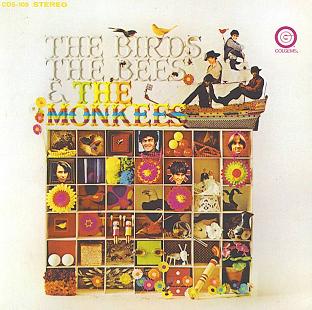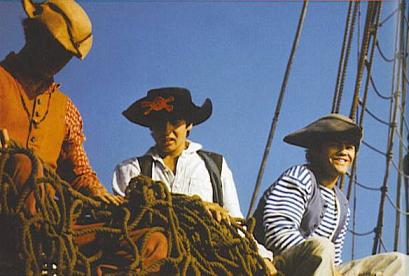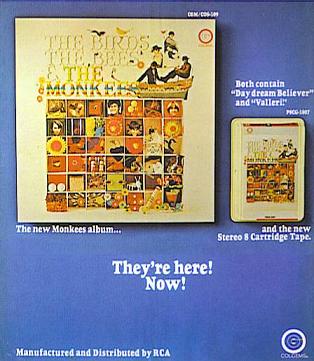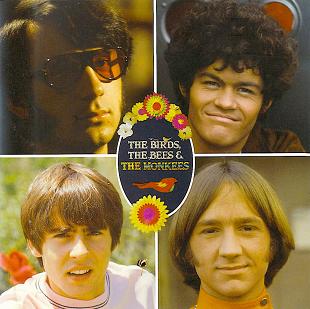CD Review: The Birds, The Bees, & The Monkees (3 CD Limited Edition Boxed Set)
 Between 1988 and 1989, when compact discs were still considered an emerging technology, Arista released the first four Monkees’ albums in this format. Aside from the historical significance, these releases did little other than get Monkees’ music back on the store shelves in an updated form. Six years later, Rhino Records obtained the complete Monkees’ catalog and began a series of excellent quality reissues that included copious liner notes and bonus tracks of unreleased material. As amazing as these releases were, Rhino began revisiting these albums in 2006 with two disc sets presenting the stereo and mono mixes of the original albums remastered with the latest equipment and featuring even more detailed background information and additional tracks. The latest entry in this series, The Monkees’ fifth album, The Birds, The Bees, & The Monkees, is also Rhino’s most impressive.
Between 1988 and 1989, when compact discs were still considered an emerging technology, Arista released the first four Monkees’ albums in this format. Aside from the historical significance, these releases did little other than get Monkees’ music back on the store shelves in an updated form. Six years later, Rhino Records obtained the complete Monkees’ catalog and began a series of excellent quality reissues that included copious liner notes and bonus tracks of unreleased material. As amazing as these releases were, Rhino began revisiting these albums in 2006 with two disc sets presenting the stereo and mono mixes of the original albums remastered with the latest equipment and featuring even more detailed background information and additional tracks. The latest entry in this series, The Monkees’ fifth album, The Birds, The Bees, & The Monkees, is also Rhino’s most impressive.
The Birds, The Bees, & The Monkees was the product of a very tumultuous time in the group’s career. While the four Monkees were fixated on making the jump to the big screen with a theatrical movie, they also had the second season of a television show to wrap up, a TV special in the works, and a new album to deliver. The four members were growing musically thanks to the constant indoctrination they were receiving from some of the most talented members of the industry and they began to explore their individual creativity. As Andrew Sandoval observes in the linear notes from this CD, The Monkees were entering their “White Album” period and several months ahead of The Beatles. The recording sessions for this album would yield not only the tracks for it, but also their next single release, several songs for their feature film soundtrack, and at least half the material for their next full album even though it would be as a trio.
 The Monkees’ first two albums, their self titled debut and More of, served as soundtracks to their wildly popular television series. The next two, Headquarters and Pisces, Aquarius, Capricorn, & Jones, Ltd., were their break out albums as they asserted more creative control over their recording careers. As The Monkees began preparation on their fifth album, they felt they had formed a passable music group and were ready to produce as well. Chip Douglass, a talented musician in his own right who had produced their previous two albums, was relieved of his duties in favor of the new record being an entirely Monkees’ produced venture.
The Monkees’ first two albums, their self titled debut and More of, served as soundtracks to their wildly popular television series. The next two, Headquarters and Pisces, Aquarius, Capricorn, & Jones, Ltd., were their break out albums as they asserted more creative control over their recording careers. As The Monkees began preparation on their fifth album, they felt they had formed a passable music group and were ready to produce as well. Chip Douglass, a talented musician in his own right who had produced their previous two albums, was relieved of his duties in favor of the new record being an entirely Monkees’ produced venture.
With the production restrictions removed, the group headed off in four different directions and logged and incredible amount of studio time in their search for new material. Davy Jones continued his trend with ballads but wandered into harder territory with songs like War Games while Dolenz tried for a fifties rock sound and sang harmonies with his sister Coco. Mike Nesmith was entering a period of Avant-garde recordings with incomprehensible titles like Auntie’s Municipal Court, Carlisle Wheeling, and Tapioca Tundra. The least utilized Monkee, Peter Tork, turned in a surprisingly strong number of contributions during these sessions including Merry-Go-Round, Tear Off the Top of My Head, and Do I Have to Do this All Over Again but was ultimately left unrepresented on the finished album. Thankfully, the latter track would find its way onto the soundtrack for their feature film, Head.
 The album produced from these sessions has an unfinished feeling to it as though it were abandoned two-thirds of the way through. It is a disjointed mix of songs that, in some cases, like Valerie, had already been featured on the television show months earlier. The versions used on the album were different than the ones on the show so many fans were disappointed it was not what they were familiar with. The original material was far from the strongest of that available, as this box set finally proves beyond a shadow of a doubt. Tunes like Davy’s melodic Dream World and We Were Made for Each Other pale in comparison to other songs he completed. Even the typically strong Michael Nesmith passed over several excellent recordings in favor of the tepid Writing Wrongs and incomprehensible Magnolia Simms (which seems to have been an elaborate practical joke to convince listeners their turntables were warped!). While Birds still proved successful in the monetary sense, it was a considerable step down from The Monkees’ previous albums and would be the final original one to do so. It was also at the tail end of these recording sessions that the group received the news that, despite solid ratings, their television show was not being renewed for a third season.
The album produced from these sessions has an unfinished feeling to it as though it were abandoned two-thirds of the way through. It is a disjointed mix of songs that, in some cases, like Valerie, had already been featured on the television show months earlier. The versions used on the album were different than the ones on the show so many fans were disappointed it was not what they were familiar with. The original material was far from the strongest of that available, as this box set finally proves beyond a shadow of a doubt. Tunes like Davy’s melodic Dream World and We Were Made for Each Other pale in comparison to other songs he completed. Even the typically strong Michael Nesmith passed over several excellent recordings in favor of the tepid Writing Wrongs and incomprehensible Magnolia Simms (which seems to have been an elaborate practical joke to convince listeners their turntables were warped!). While Birds still proved successful in the monetary sense, it was a considerable step down from The Monkees’ previous albums and would be the final original one to do so. It was also at the tail end of these recording sessions that the group received the news that, despite solid ratings, their television show was not being renewed for a third season.
In 1968, stereophonic recordings had firmly taken hold and their mono counterparts were being phased out. Birds was the first Monkees’ album to be released in the new Stereo 8 Track process and was originally intended as a stereo only release. When Columbia’s foreign distributors in areas that were not as technologically advanced as the United States got wind of this, they demanded a mono mix of the album. A single channel version was hastily assembled but the timing on several tracks differed significantly from the stereo pressings. The mono LP of Birds is highly sought after by collectors and lends itself perfectly to Rhino’s new series of stereo/mono deluxe CD releases. Each version of the album is afforded its own CD and is supplemented by over a dozen extra tracks of alternate and unreleased songs.
 Rhino wisely broke with tradition on this release and added a third CD to upgrade this to a boxed set. This bonus CD is comprised of thirty-one rare tracks that provide an exhausting look at the sessions for this album. Some of this music may be familiar to fans that have followed the Rhino releases since day one, now all conveniently collected in one spot, but others are true rarities like the Davy Jones version of Jan Berry’s Laurel and Hardy. Also included are alternate versions of the follow up single D.W. Washburn / It’s Nice to Be with You and tracks that would eventually be used on the Head soundtrack and the Instant Replay album.
Rhino wisely broke with tradition on this release and added a third CD to upgrade this to a boxed set. This bonus CD is comprised of thirty-one rare tracks that provide an exhausting look at the sessions for this album. Some of this music may be familiar to fans that have followed the Rhino releases since day one, now all conveniently collected in one spot, but others are true rarities like the Davy Jones version of Jan Berry’s Laurel and Hardy. Also included are alternate versions of the follow up single D.W. Washburn / It’s Nice to Be with You and tracks that would eventually be used on the Head soundtrack and the Instant Replay album.
The three compact discs come packaged in thin cardboard sleeves inside an over sized gatefold box. Also included is an excellent twenty-five page booklet which provides a thorough examination of the sessions that yielded these recordings and some rare photographs. There is also a reproduction of a promotional button for the album. This may not fit well on most CD shelves and fans will probably want to transfer the discs to standard cases to prevent scratching, but it is an impressive package.
While not recommended for the casual or recent Monkees fan, The Birds, The Bees, & The Monkees Boxed Set is a long awaited treasure for collectors and advanced listeners. The album represents a fascinating period of change in the career of a unique manufactured musical group and demonstrates that, while they may not have played their own instruments in the beginning, each member had musical talent. If greater care had gone into the track selection, this album might have proven as popular as earlier releases and heralded several more years of successful records. The $60 price tag also restricts this set’s appeal but this is a limited release from Rhino Records Hand Made division and is almost certain to appreciate in value once it sells out.
